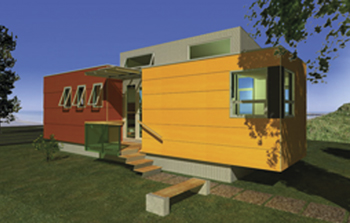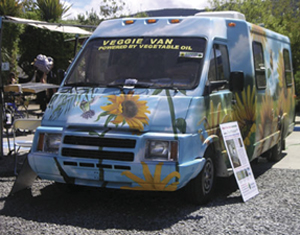Beyond the VW Van - The New Nomadics
By Wendy Priesnitz

The miniHOME © Andy R. Thomson |
I first became interested in the mobile lifestyle in 1971, when my husband persuaded me to vacate our apartment and move into a VW van that we “camperized”. (When I met him the year before, all of his possessions were housed in his Fiat, which should have been my first clue that something different was ahead in terms of living spaces.) After our daughters were born a few years later, we briefly lived in an apartment and then bought a house, only to move full-time into a Winnebago motor home for a year or so.
Since then, I’ve always kept my eyes open for mobile housing – gypsy wagons, houseboats, airstream trailers, RVs, tents, yurts, prefab homes, and old converted school buses to name just a few of the possibilities.
Apparently, others share this interest in what California-based prefab designer Jennifer Siegal calls the “new nomadism.” The Recreational Vehicle Industry Association estimates that there are about one million full-time RVers in the United States. The nomadic trend has been fed by a flexible infrastructure of cell phones, and wireless and satellite Internet connections, as well as a growing network of RV parks catering to a mobile populace who want to experience the joys of warm-climate and coastal living but can’t afford the real estate. There are families taking a year off to travel, self-employed people enjoying the work-at-home experience with a twist, those looking for a tiny house living experience, and, of course, retirees.
Not all mobile dwellings are expensive, commercially-built behemoths. Many low-budget migratory-minded folks have turned ordinary modes of transportation like vans, school buses, and trucks into creative living spaces. And living in their vehicle has driven more than one young person to a student loan-fueled education.
Not surprisingly, the urban vehicle camping trend (along with poverty and a shortage of affordable housing forcing people to live in their cars) has cities grappling with the desire of some of its residents to live in their vehicles. Permanent residents worry about parking, traffic, infrastructure, and property value issues. That, in turn has opened up some interesting discussions about control of and access to public space.
Another pertinent issue is the effect of this lifestyle on health and the environment. Most commercially produced RVs and many home-built conversions use materials and processes that are less than green. But there are no bylaws prohibiting the installation of a composting toilet in a vehicle, and nothing to stop a handyperson from using healthy, sustainable materials in a conversion.
As well as conserving space, this style of living can also conserve resources. When our young family lived the mobile life, we found ourselves conserving water, a habit that remains many decades later. When you pump it by hand and know the holding tank has a finite (and small) capacity, you are careful about every drop you use. And if you choose not to park in RV campgrounds, you also get creative and conservation-minded about electricity usage. Some vehicles (including a sail boat we recently saw) sport small solar panels; others install halogen and LED lights.
And then there is the obvious environmental argument against the operation of any sort of vehicle. When we lived the mobile lifestyle, we found that having our home with us at all times actually reduced commuting and other driving time. Other modern nomads address the greenhouse gas emissions issue by converting to bio-diesel. The so-called Veggie Van (pictured below) has logged over 25,000 miles on biodiesel. Not only does the three-ton, biodiesel-powered motor home get 25 miles per gallon on vegetable oil fuel, but its exhaust also smells like French fries. The driver, Josh Tickell is also the author of From the Fryer to the Fuel Tank: The Complete Guide to Using Vegetable Oil as an Alternative Fuel.

The bio-diesel powered
Veggie Van
photo courtesy Veggie Van |
Fortunately, the new nomadism is being embraced by a growing number of sustainably-minded architects and designers. In fact, Toronto-based Andy R. Thomson calls the “eco-rv” community “the last legal loophole available for truly affordable, experimental, eco-living.” His opinion comes from personal experience. When he was a student at the University of British Columbia in Vancouver in 2001, he and his family lived in an 108-square-foot 1971 GMC step van with onboard solar, called VanZilla. He says, “As a designer with a deep concern for the preservation of the planetary ecosystem, the primary focus in my personal life has been to discover a viable and affordable form of housing.” His goal is to create housing spaces that consume one-tentth of the resources and energy of traditional housing forms.
One of Thomson’s projects was launched in 2005. The miniHOME (pictured at the start of this article) sits on a 8-foot by 36-foot trailer chassis, and features SIPS (structural-insulated panel system) construction, a B100-Biodiesel powered cogenerating energy plant with optional solar and wind backup, a novel passive-HRV (heat-recovery ventilator), composting toilet, rainwater and greywater systems, LED-Halogen lights and computer-integrated controls, making the unit easy to operate and maintain. The roughly 400-square-foot unit was built to exceed USGBC and CGBC LEED Platinum standards for energy efficiency. The miniHOME features healthy, non-toxic materials and durable assemblies, all using the latest in building science envelope design.
This new generation of mobile and prefab dwellings harkens back to Buckminster Fuller’s geodesic dome and Dymaxion House inventions, which were admittedly a bit before their time. Conceived and designed in the late 1920s, the Dymaxion House used tension suspension from a central column or mast, sold for the price of a Cadillac and could be shipped worldwide in its own metal tube.
Jennifer Siegal launched her Venice, California company, called Office of Mobile Design, after noticing the bad design that characterized mobile homes and trailers. She designs and sells two structures – the Portable House and the Swellhouse. The modular Portable House is completely assembled at the factory and arrives ready to install. Buyers can choose from 10 floor plans and two sizes, depending on their needs and budget. The Swellhouse is a customizable residence made up of panelized walls on a steel frame; the components are shipped and assembled on site.
Modern nomads in Europe, especially the urban sort, have yet another option (if zoning bylaws allow). The innovative Loftcube is a pod-like portable house that perches on top of a building and looks a bit like a spaceship. These mobile living units, placed on flat roofs by helicopters or cranes and connected to the building’s utilities, offer additional living space in big cities. The Loftcube, devised by the German designer Werner Aisslinger, is extraordinarily compact: The loft cube is made up of an open-space for living, dining and cooking, and a separate sleeping area and bath.
After my family gave up living in vehicles and began living in more permanent structures, we accumulated more possessions because we had the space to house them. However, because we retained our restlessness, it was harder and more expensive to move. And move we did, seldom staying in one place for more than a season. Eventually, we settled down and I was finally able to plant perennials and be there to see them come up the next year. But thirty years later, my husband and I are shedding those possessions and once again living in a tiny – if stationary – space. Now it’s about that sailboat with solar panels we were admiring the other day....
Learn More
Andy Thomson’s miniHome Sustain Design Studio, Toronto, ON Canada www.sustain.ca
Jennifer Siegal Office of Mobile Design, Venice, CA USA www.designmobile.com
Werner Aisslinger’s Loftcube Studio Aisslinger, Berlin, Germany www.loftcube.net
Workers on Wheels Resources for RVers www.workersonwheels.com
Mobile: The Art of Portable Architecture by Jennifer Siegal (Princeton Architectural Press, 2002)
Car Living Your Way: Stories and Practical Tips From Those Who Have Been Down the Road by A.J. Heim (Touchstone Adventures, 2001)
Portable Houses by Irene Rawlings, Mary Abel (Gibbs Smith, Publisher, 2004)
Wendy Priesnitz is Natural Life Magazine's editor, an award-winning journalist with over 40 years of experience, and the author of 13 books.
This article was published in Natural Life Magazine in 2005 and updated in 2018.
|

